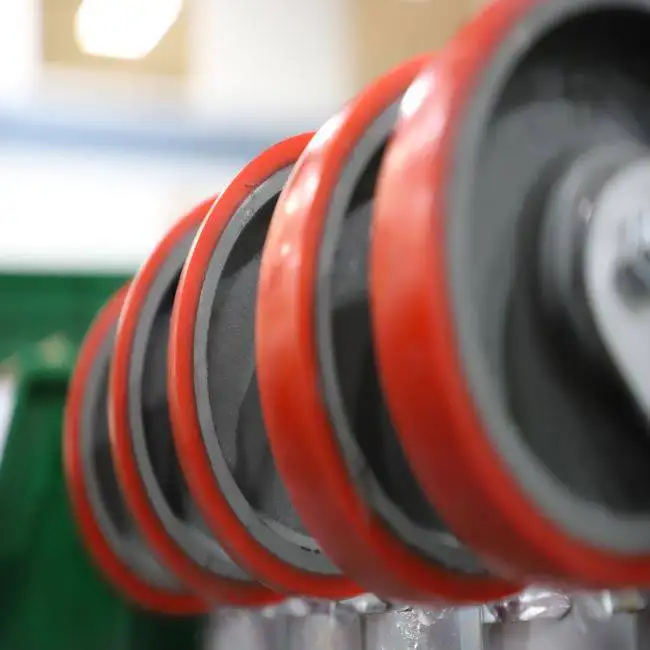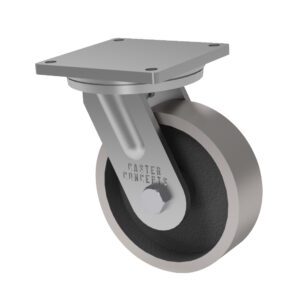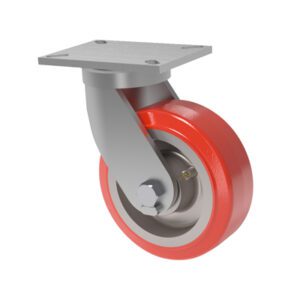

Choosing the proper heavy-duty industrial caster depends largely upon the application. Not all casters created equal , and to guarantee optimal caster performance, it’s critical to select the correct design for the swivel section of the caster.
There are two main designs for the swivel section of a heavy-duty industrial caster: kingpin and kingpinless. Both have advantages and disadvantages. This post outlines both designs, their pros and cons, and possible applications for each.

Kingpin Caster
The kingpin design is one of the oldest types of caster swivel sections. A rivet or bolt, and nut fasten together the top plate and the fork assembly. This design uses a load bearing and a thrust bearing to transmit the load. In this post all kingpin designs refer to threaded kingpins with slotted nuts, the standard for most heavy-duty industrial swivel casters.
By contrast, kingpinless designs have only three components: a top plate with ball race, a yoke base with ball race, and ball bearings. The design is similar to that found inside a ball bearing.
Kingpin casters have two main advantages. Kingpins can be tightened to adjust swivel resistance. For example, if the load sits on an incline the kingpin can be tightened to a larger torque value, thus decreasing swivel ability. Second, the threaded kingpin-nut design allows adjustments to the kingpin nut as the swivel section wears, which can prolong the caster life. This also provides easier access to clean the swivel section.
The biggest drawback of the kinpin design is that most of the thrust loads transmit through the kingpin. An improperly designed kingpin can shear off under load, causing caster failure. Thus, kingpin casters aren’t usually recommended for towing applications, where high-speed turns can reduce the capacity of a kingpin swivel section. When designing for an application that uses kingpin swivel casters, it’s critical to achieve the proper kingpin design.
Kingpinless casters are advantageous because the kingpin is eliminated, which spreads load over a larger area. This lets the caster swivel at higher speeds without risk of shearing and failure. Kingpinless casters also swivel more easily and require less maintenance because there is no nut to retighten.

Kingpinless Caster
One drawback of kingpinless casters is that once assembled, it’s very difficult to adjust swivel ability. Adjustments require dismantling the entire swivel section to insert a swivel restrictor device into the raceway. Further, once the caster swivel section raceways have worn, it’s impossible to adjust the swivel section to retighten.
Both designs have existed for decades, each with advantages and drawbacks. It’s critical to understand loading conditions, speed, duty cycle, jobs-per-hour, floor conditions, and any environmental concerns in order to choose the proper swivel section for the application.
Our engineering staff at Caster Concepts Inc. can help determine which swivel section best suits your needs. Our engineers have extensive experience designing casters for an array of applications. Properly designing the swivel section yields a long-lasting industrial caster that performs optimally for the customer.
At Caster Concepts Inc., we will work with you to find the product that best fits your needs. Caster Concepts Inc. is an ISO 9001-2015 certified designer and manufacturer of a comprehensive line of industrial casters, ranging from a medium-duty series to a heavy-duty series for any application. CCI also manufactures caster wheels to withstand impact, corrosion, temperature extremes and chemicals found in harsh industrial environments.
For further information, please contact us at customercentral@casterconcepts.com or call 517-680-7950. We are here to help!